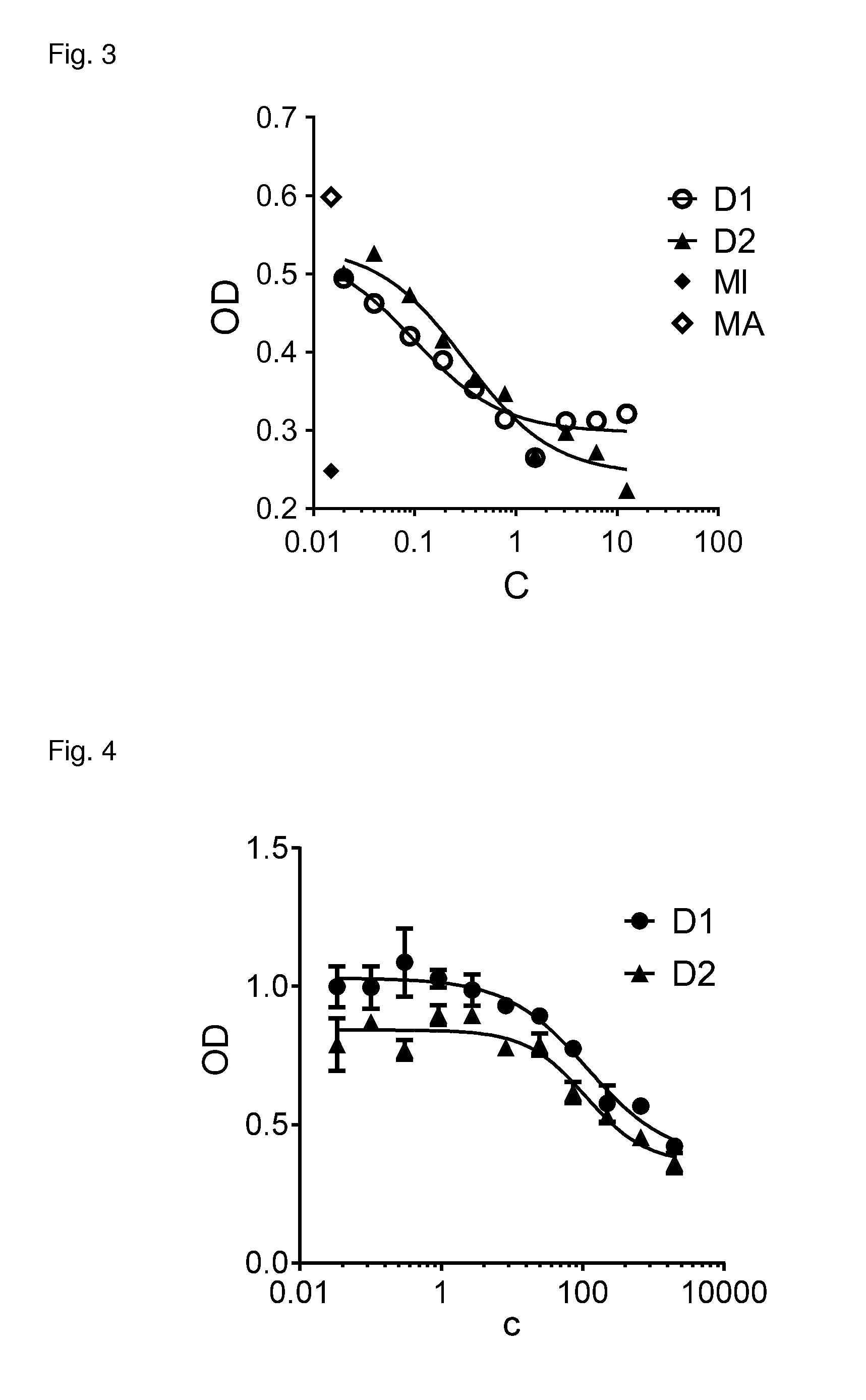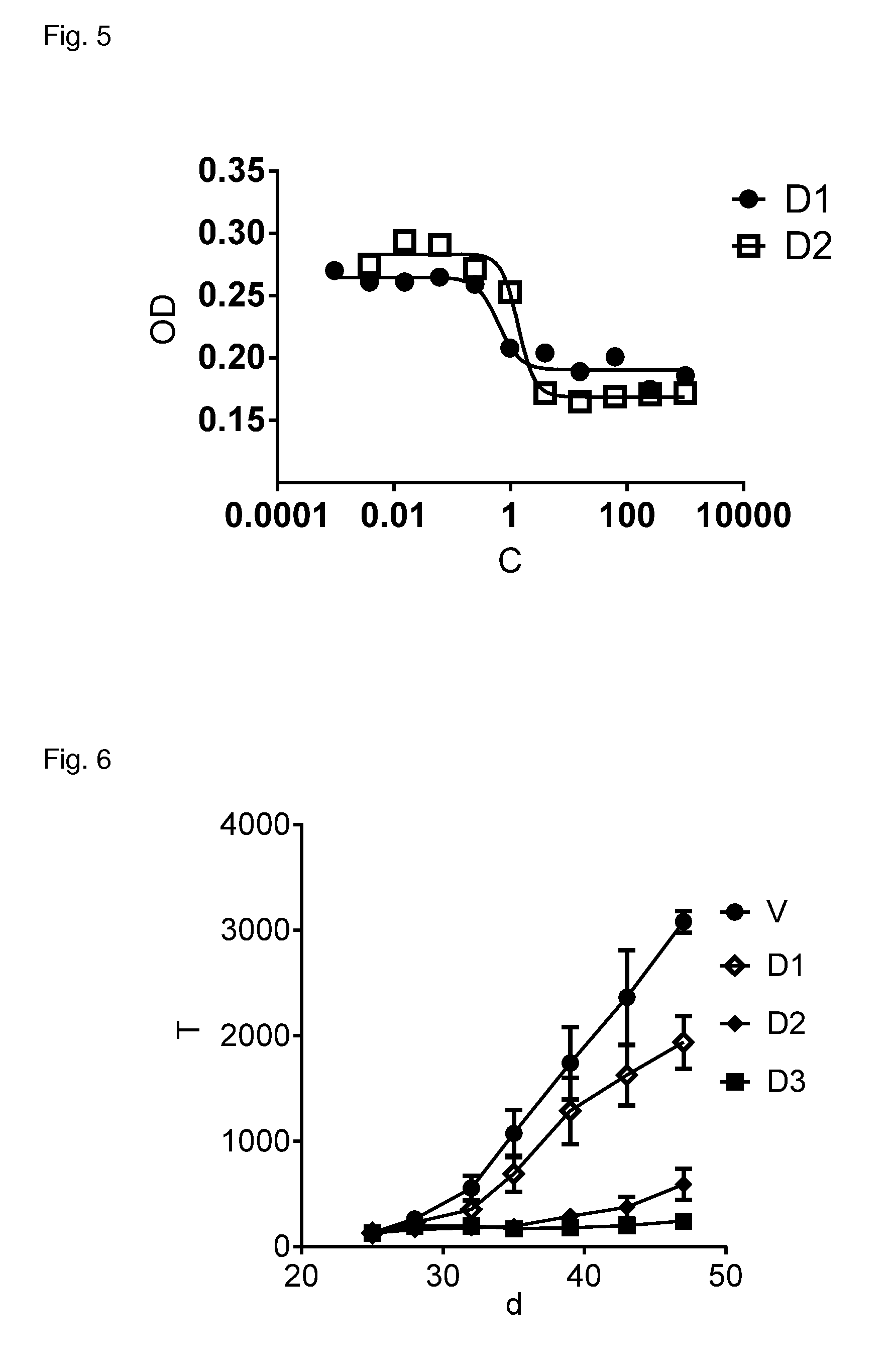Designed ankyrin repeat proteins binding to hepatocyte growth factor
a technology of hepatocyte growth factor and ankyrin, which is applied in the direction of peptide/protein ingredients, peptide sources, drug compositions, etc., can solve the problems of increased risk of tumor metastasis, poor prognosis, and concentration of circulating hg
- Summary
- Abstract
- Description
- Claims
- Application Information
AI Technical Summary
Benefits of technology
Problems solved by technology
Method used
Image
Examples
example 1
Selection of Binding Proteins Comprising an Ankyrin Repeat Domain with Binding Specificity for HGF
[0176]Using ribosome display (Hanes, J. and Plückthun, A., PNAS 94, 4937-42, 1997) many designed ankyrin repeat proteins (DARPins) with binding specificity for HGF were selected from DARPin libraries as described by Binz et al. 2004 (loc. cit.). The binding of the selected clones toward specific (HGF) and unspecific (MBP, E. coli maltose binding protein) targets was assessed by crude extract ELISA, indicating that hundreds of HGF binding proteins were successfully selected. For example, the ankyrin repeat domains of SEQ ID NO: 33 to 61 constitute amino acid sequences of selected binding proteins comprising an ankyrin repeat domain with binding specificity for HGF. Individual ankyrin repeat modules from such ankyrin repeat domains with binding specificity to HGF are provided in SEQ ID NO: 12 to 25.
Selection of HGF Specific Ankyrin Repeat Proteins by Ribosome Display
[0177]The selection of...
example 2
Characterization of the DARPins with Binding for Specificity for HGF by Surface Plasmon Resonance Analysis
[0181]Human HGF molecules were directly immobilized in a flow cell and the interaction with various selected DARPins was analyzed.
Kd Determination by Surface Plasmon Resonance (SPR) Analysis
[0182]SPR was measured using a ProteOn instrument (BioRad) and measurement was performed according standard procedures known to the person skilled in the art. The running buffer was PBS, pH 7.4, containing 0.005% Tween 20®. Human HGF was covalently immobilized on a GLC chip (BioRad) to a level of about 5000 resonance units (RU). The interaction of DARPin and HGF was then measured by injecting 200 μl running buffer (PBS containing 0.005% Tween®) containing serial dilutions of DARPins of concentration of 25, 12.5, 6.26, 3.13 and 1.67 nM (on-rate measurement), followed by a running buffer flow for 25 minutes at a constant flow rate of 100 μl / min (off-rate measurement). The signals (i.e. resonanc...
example 3
Inhibition of HGF Induced c-Met Phosphorylation by DARPins with Binding Specificity for HGF
[0184]A549 cells were seeded in complete medium (DMEM; 10% FBS) in 96 well plates at 50,000 cells per well. 24 h later, medium was replaced by serum-free medium. Cells were incubated for another 24 h and stimulated by 1 nM human HGF in the presence and absence of DARPin. HGF and DARPin were preincubated for at least 30 min at room temperature prior to addition to cells. Cells were stimulated for 10 minutes under cell culture conditions. Stimulation was terminated by removing the cell supernatant (by flicking) and addition of cell lysis buffer (RIPA; Sample Diluent Concentrate 2; RnDSystems). Phosphorylated c-Met (P-cMet) levels in cell lysates were determined using the Human Phospho-HGF R / c-MET DuoSet IC (RnD Systems) according to the manufacturers' protocol. Data were analyzed using GraphPad Prism software (GraphPad Software Inc., CA, USA). The percentage inhibition of phosphorylation was cal...
PUM
| Property | Measurement | Unit |
|---|---|---|
| dissociation constant | aaaaa | aaaaa |
| Tm | aaaaa | aaaaa |
| concentrations | aaaaa | aaaaa |
Abstract
Description
Claims
Application Information
 Login to View More
Login to View More - R&D
- Intellectual Property
- Life Sciences
- Materials
- Tech Scout
- Unparalleled Data Quality
- Higher Quality Content
- 60% Fewer Hallucinations
Browse by: Latest US Patents, China's latest patents, Technical Efficacy Thesaurus, Application Domain, Technology Topic, Popular Technical Reports.
© 2025 PatSnap. All rights reserved.Legal|Privacy policy|Modern Slavery Act Transparency Statement|Sitemap|About US| Contact US: help@patsnap.com



